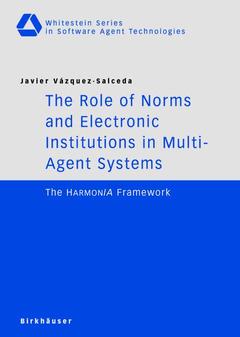The Role of Norms and Electronic Institutions in Multi-Agent Systems, 2004 The HarmonIA Framework Whitestein Series in Software Agent Technologies and Autonomic Computing Series
Langue : Anglais
Auteur : Vazquez-Salceda Javier

"It is not the consciousness of men that defines their existence, but, on the contrary, their social existence determines their consciousness." Karl Marx In recent years, several researchers have argued that the design of multi-agent sys tems (MAS) in complex, open environments can benefit from social abstractions in order to cope with problems in coordination, cooperation and trust among agents, problems which are also present in human societies. The agent-mediated electronic institutions (e-institutions for short) is a new and promising field which focuses in the concepts of norms and institutions in order to pro vide normative frameworks to restrict or guide the behaviour of (software) agents. The main idea is that the interactions among a group of (software) agents are ruled by a set of explicit norms expressed in a computational language representation that agents can interpret. Such norms should not be considered as a negative constraining factor but as an aid that guides the agents' choices and reduces the complexity ofthe environment making the behaviour of other agents more predictable.
I Applying Electronic Institutions and Norms to Complex Domains.- 1 Introduction.- 2 CARREL: an Agent-Mediated System for Organ and Tissue Allocation.- 3 Norms, Agents and Electronic Institutions.- II HARmoNIA: a New Approach to Model Electronic Institutions.- 4 A Multi-Layered Normative Framework for Agents.- 5 A Multi-Layered Framework for Organizations.- 6 Applying HARMONÍA to the Organ and Tissue Allocation Problem.- 7 Conclusions.- III Appendix and Bibliography.- A Medical Data Protection and the Internet.- A.1 Medicine, Information Technology and Privacy.- A.2 Advantages of Electronic Formats for Medical Data.- A.3 Requirements to be Fulfilled.- A.3.1 Requirements from the Medical Community.- A.3.2 Law-Enforced Requirements.- A.4 Privacy and Security of Electronic Medical Data.- A.5 Security Measures for Medical Information Systems.- A.6 Desirable Characteristics of a Medical Information System.- A.7 The New Users of Medical Data.- A.8 Summary.- B The UCTx System.- B.1 Creating a Multi-Agent System for a Hospital’s Transplant Unit.- B.2 An Example: The Cornea Transplantation.- B.3 Summary.- List of Acronyms.- Authors Index.
A survey on current approaches is presented The different abstraction levels involved in a normative framework (values, norms, rules, procedures) are identified and connected The influence of context for each abstraction level is identified A real example in the medical domain is presented, applying the new approach
Ouvrage de 274 p.
17.8x25.4 cm
© 2024 LAVOISIER S.A.S.



